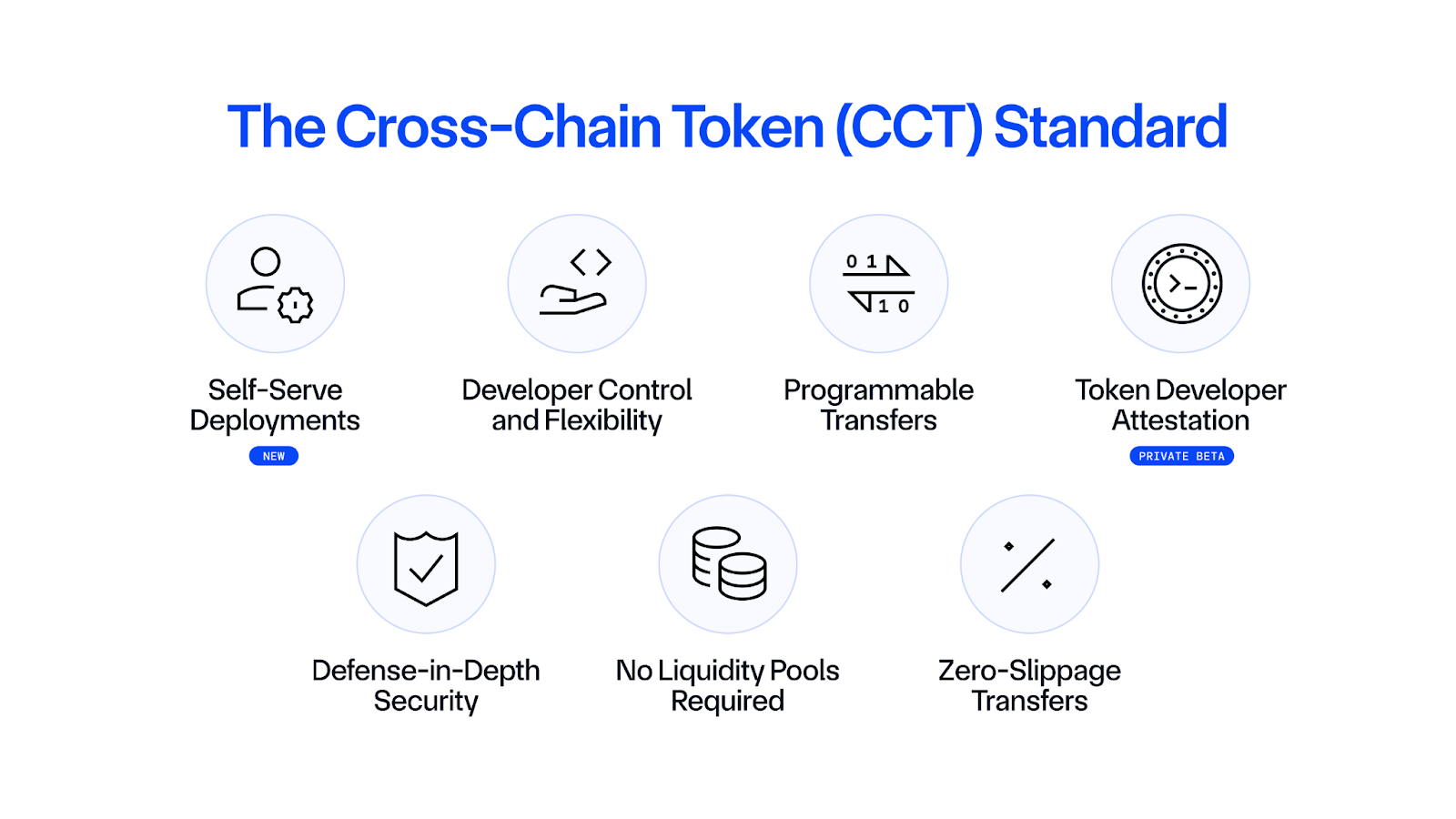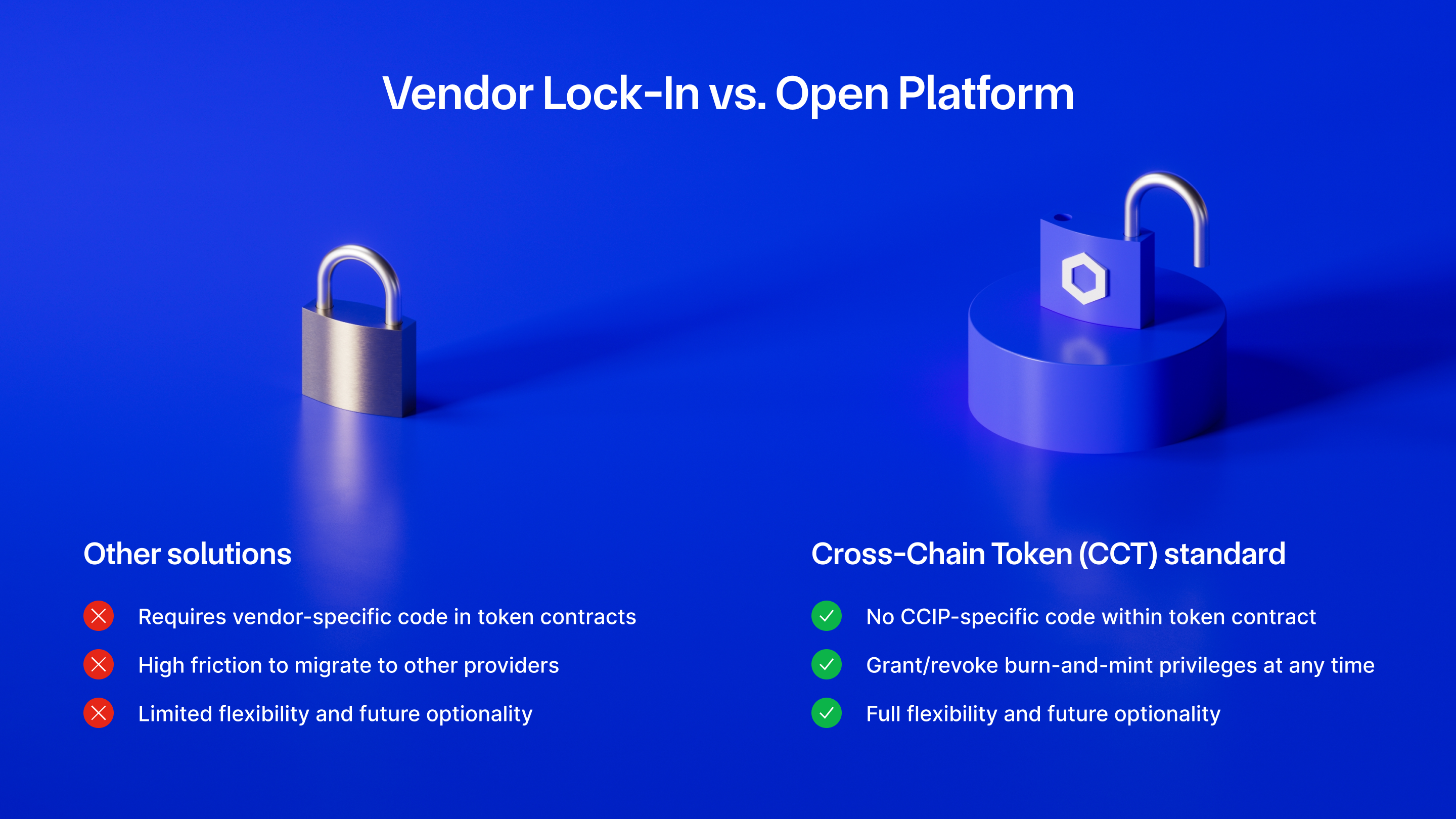How Chainlink CCIP Eliminates Vendor Lock-In To Empower Token Issuers
Flexibility is essential for token developers. To meet these needs the CCIP v1.5 upgrade introduced the Cross-Chain Token (CCT) standard, which enables self-serve integration of new and existing tokens with CCIP in minutes. The CCT standard provides developers with full control over their token operations while mitigating vendor lock-in.
Unlike other cross-chain solutions that force dependency on a single provider, CCTs empower token issuers with autonomy, security, and seamless upgradability. Token developers retain full ownership of their token contracts, CCIP token pools, and customized implementation logic, including rate limits across chains. This eliminates the need for vendor lock-in, hard-coded logic, or reliance on third-party infrastructure—allowing developers to customize functionality without sacrificing security.
In this post, we’ll explore how CCTs help avoid vendor lock-in and deliver token developers greater flexibility.
Understanding Cross-Chain Tokens (CCTs)
CCTs enable token issuers to deploy and manage cross-chain token pools with ease. CCTs are token logic agnostic, meaning token developers can:
- Deploy pre-audited token pool contracts to turn any ERC20-compatible token into a CCT.
- Create custom token pool contracts for bespoke token use cases.
Importantly, CCTs do not require token developers to embed CCIP-specific code into their token’s smart contract. This means token developers retain autonomy and flexibility over their cross-chain implementation.

The Problem With Vendor Lock-In
Existing cross-chain solutions restrict token developer autonomy through various mechanisms:
- Smart contract dependencies—Some solutions require core token logic to be coupled with a specific cross-chain messaging layer, limiting future flexibility and introducing risk.
- Complex contract interactions—Some solutions make migration difficult by entangling token developers in intricate contract dependencies, effectively locking them into a single solution.
- Liquidity pool reliance—Many cross-chain systems rely on liquidity pools, forcing token issuers to maintain locked assets in third-party-controlled pools, which adds counterparty risk and operational constraints.
When projects face security breaches, service disruptions, or changing ecosystem needs, upgrading from such solutions can be highly difficult and costly—as seen with past incidents involving cross-chain solutions.
How Chainlink CCIP Eliminates Vendor Lock-in

Chainlink CCIP and the CCT standard avoids these issues by offering:
- Full ownership and control—With CCIP, developers retain complete ownership over their token contracts and cross-chain token pools by default. This ensures that token issuers can configure their token flows, enforce custom rate limits, and upgrade their implementation without dependency on third-party protocols.
- Decoupled cross-chain logic—Unlike solutions that require embedding cross-chain messaging logic directly into a token contract, CCTs do not require token developers to inherit any CCIP-specific code within their token’s smart contract. This allows token developers to upgrade their cross-chain strategy without modifying their core token contract, significantly reducing technical lock-in.
- Seamless migration—Since CCTs do not require developers to inherit any CCIP-specific code within their token contract, token developers can upgrade to the most secure solution once it becomes available on the chain they are deploying their token on. This means developers can seamlessly upgrade to CCIP without reissuing tokens, reducing friction for both users and ecosystem partners.
- Liquidity pool autonomy—CCTs enable token issuers to retain full control over their token pools. When using a Lock and Mint token transfer mechanism, liquidity is locked on the source chain, while CCTs ensure that this liquidity remains under the token issuer’s control rather than being managed by a third party.
Notably, certain high-growth sectors—such as security-focused assets like stablecoins and other tokenized real-world assets (RWAs)—stand to benefit significantly from avoiding vendor lock-in. These projects are often supported by key capital markets participants, making security, flexibility, and long-term scalability essential considerations in their cross-chain strategy. CCIP’s ability to eliminate external dependencies and enable seamless upgrades aligns with the needs of these growing asset classes.
Seamlessly Create a CCT With Token Manager
The CCIP Token Manager empowers token developers to seamlessly register, configure, and manage CCTs and token pools across multiple blockchain networks, including no-code, guided token deployments.
The CCIP Token Manager complements existing CLI methods and simplifies the process of deploying new CCTs or transforming existing tokens into CCTs. After deploying a CCT, CCIP-powered bridging applications such as Transporter, XSwap, and other interfaces can provide a frontend interface for users to transfer the token.
Conclusion
Cross-chain solutions should prioritize developer autonomy and security. CCIP provides token issuers with a vendor-agnostic solution that eliminates smart contract dependencies, enables seamless migration, and avoids liquidity pool reliance. By adopting the CCT standard, token developers can ensure long-term flexibility while benefiting from the Chainlink standard’s defense-in-depth security infrastructure.
If you’re looking to adopt the CCT standard, check out the official Chainlink documentation. To learn more about Chainlink, visit chain.link, subscribe to the Chainlink newsletter, and follow Chainlink on X and YouTube.
